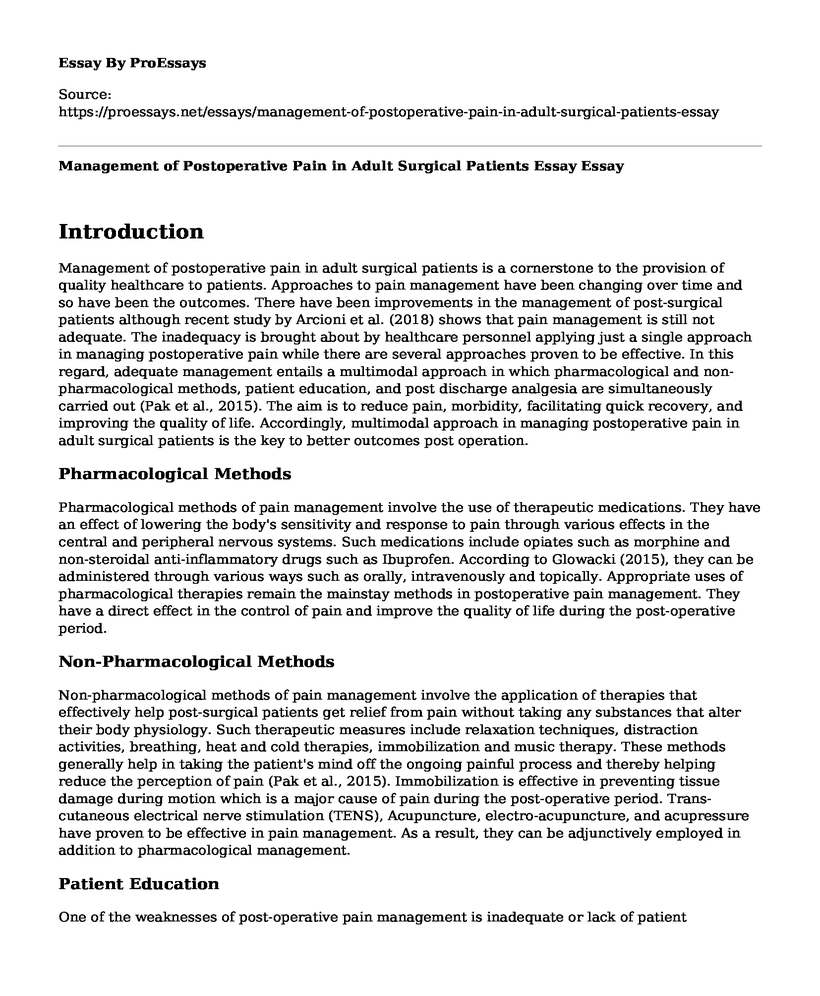Introduction
Management of postoperative pain in adult surgical patients is a cornerstone to the provision of quality healthcare to patients. Approaches to pain management have been changing over time and so have been the outcomes. There have been improvements in the management of post-surgical patients although recent study by Arcioni et al. (2018) shows that pain management is still not adequate. The inadequacy is brought about by healthcare personnel applying just a single approach in managing postoperative pain while there are several approaches proven to be effective. In this regard, adequate management entails a multimodal approach in which pharmacological and non-pharmacological methods, patient education, and post discharge analgesia are simultaneously carried out (Pak et al., 2015). The aim is to reduce pain, morbidity, facilitating quick recovery, and improving the quality of life. Accordingly, multimodal approach in managing postoperative pain in adult surgical patients is the key to better outcomes post operation.
Pharmacological Methods
Pharmacological methods of pain management involve the use of therapeutic medications. They have an effect of lowering the body's sensitivity and response to pain through various effects in the central and peripheral nervous systems. Such medications include opiates such as morphine and non-steroidal anti-inflammatory drugs such as Ibuprofen. According to Glowacki (2015), they can be administered through various ways such as orally, intravenously and topically. Appropriate uses of pharmacological therapies remain the mainstay methods in postoperative pain management. They have a direct effect in the control of pain and improve the quality of life during the post-operative period.
Non-Pharmacological Methods
Non-pharmacological methods of pain management involve the application of therapies that effectively help post-surgical patients get relief from pain without taking any substances that alter their body physiology. Such therapeutic measures include relaxation techniques, distraction activities, breathing, heat and cold therapies, immobilization and music therapy. These methods generally help in taking the patient's mind off the ongoing painful process and thereby helping reduce the perception of pain (Pak et al., 2015). Immobilization is effective in preventing tissue damage during motion which is a major cause of pain during the post-operative period. Trans-cutaneous electrical nerve stimulation (TENS), Acupuncture, electro-acupuncture, and acupressure have proven to be effective in pain management. As a result, they can be adjunctively employed in addition to pharmacological management.
Patient Education
One of the weaknesses of post-operative pain management is inadequate or lack of patient education. Patients need to know that they will experience pain post-operation. They need to know how and when to take their pain medications and the possible side effects of the medications (Apfelbaum et al., 2013). In addition, they should be informed how to take care of the surgical wound and the danger signs that should make them seek urgent care from a professional.
Post discharge Analgesia
Pain management is not adequate if done during the hospital stay and not covered once the patient has been discharged. Patients should get prescriptions that are convenient to take to aid compliance such as single dose regimens (Apfelbaum, 2013). Adequate analgesia prescription and compliance reduces the incidences of moderate and severe pain experienced by post-operative patients.
References
Apfelbaum, J., Chen, C., Mehta, S., & Gan, A. (2013). Postoperative Pain Experience: Results from a National Survey Suggest Postoperative Pain Continues to Be Undermanaged. Anesthesia & Analgesia, 97(2), 534-540. doi: 10.1213/01.ane.0000068822.10113.9e
Arcioni, R., Palmisani, S., Tigano, S., Santorsola, C., Sauli, V., & Romano, S. et al. (2018). Strategies of reducing pain and morbidity among post-operative patients. Journal of Physiological Pain. 3(2), 248-256.
Glowacki, D. (2015). Effective pain management and improvements in patients' outcomes and satisfaction. Journal of Pain Assessment, 13(6), 122-129.
Pak, S., Micalos, P., Maria, S., & Lord, B. (2015). Nonpharmacological Interventions for Pain Management in Paramedicine and the Emergency Setting: A Review of the Literature. American Journal of Surgery, 6(2), 312-319.
Cite this page
Management of Postoperative Pain in Adult Surgical Patients Essay. (2022, Jun 17). Retrieved from https://proessays.net/essays/management-of-postoperative-pain-in-adult-surgical-patients-essay
If you are the original author of this essay and no longer wish to have it published on the ProEssays website, please click below to request its removal:
- Autism Spectrum Disorder: Etiology and Diagnosis
- STI in Teenagers in the State of Hawaii Essay
- Healthcare Quality Management Paper Example
- Essay Sample on Material and Methods of Dentistry
- Essay on Youths' Increase in Hookah Smoking: Early Exposure & Mythical Beliefs
- Paper Example on COVID-19: Global Pandemic Impact on Nations & Borders
- Free Report Example on Prisoners as Test Subjects: Pros & Cons of Holmesburg Case







